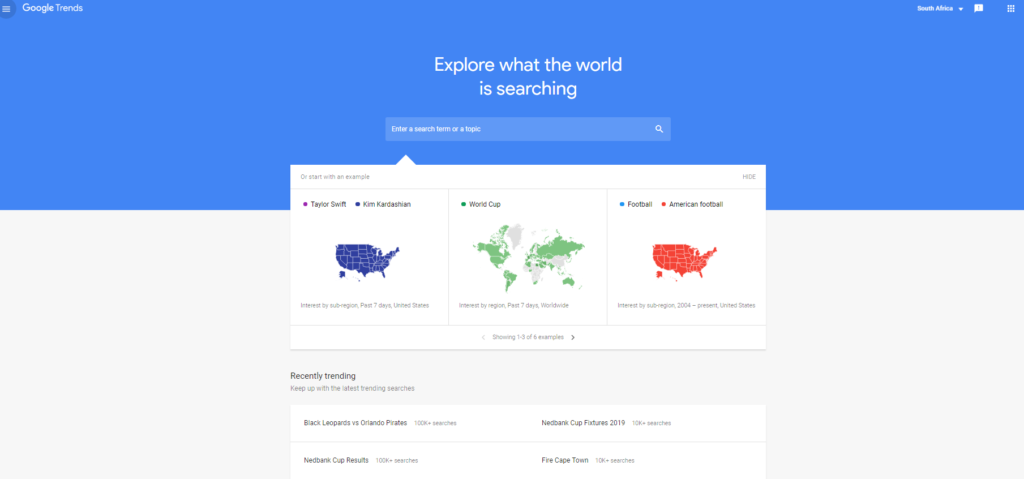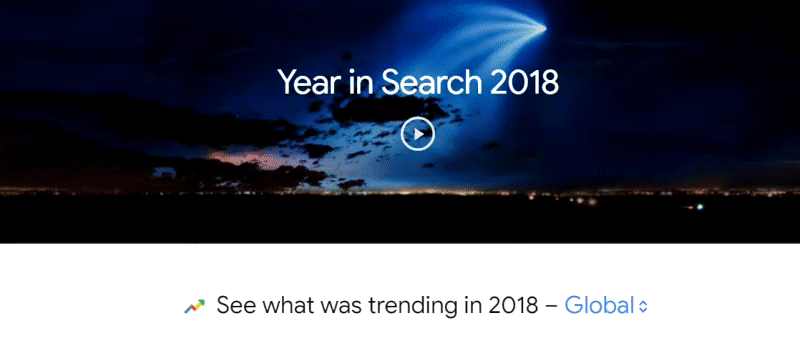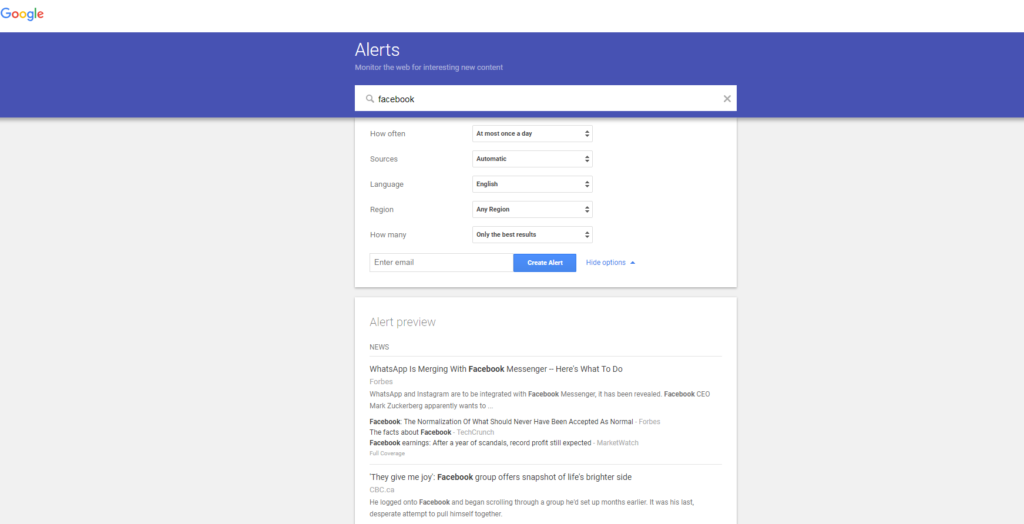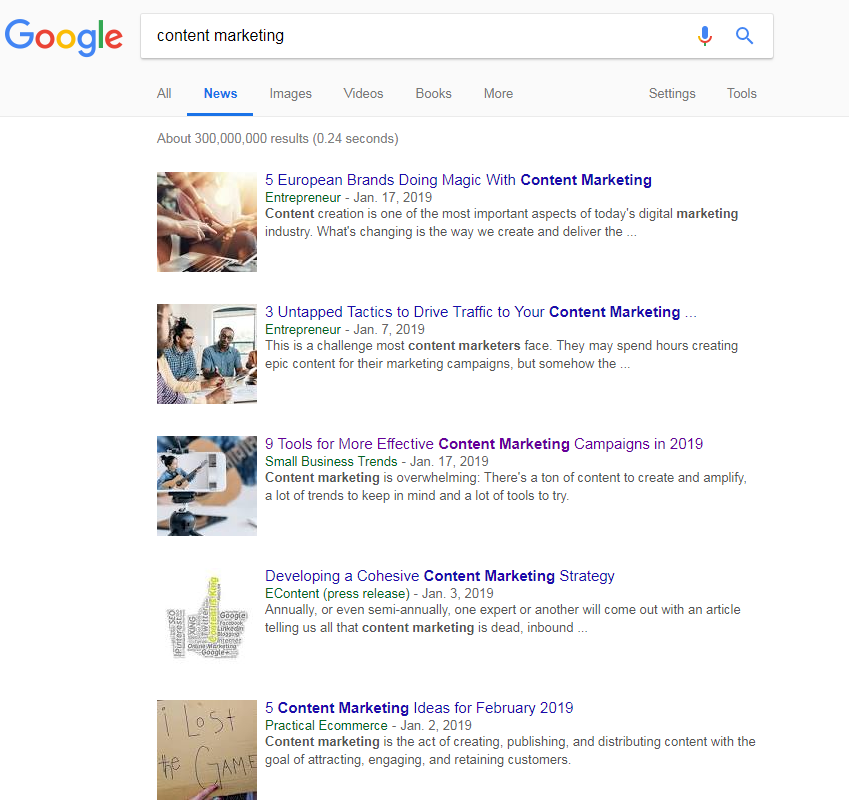Do you ever sit down to draft your content calendar and hit a blank?
Google can help you generate original, relevant content ideas for your company blog.
Google provides three free ways to generate unique and timely website content ideas :
- Google Trends
- Google Alerts
- Google News
Find out What the People Want and Give it to Them
Google Trends analyses the popularity of search terms, and the results can provide inspiration for several content ideas.

Search Term Popularity
When you enter a search term, you’ll see a graph showing the popularity of term over a specific time period. You can select from the past week, ten years or define your own custom range.
There are a few ways you can use the data to drive content that people are looking for.
Provide an analysis of the numbers
If you’re managing a social media agency, you’d have been paying close attention to the battle between Snapchat Stories and Instagram stories over past year two years. It was brutal, and eventually saw Snapchat losing ground to Instagram’s Stories clone.
A Google Trends graph provides a graphic illustration of the fall of Snapchat stories and the accompanying rise of Instagram’s offering.
This type of digital asset could power a commentary on why Snapchat lost out, and visually you could peg developments to the timeline on the trends graph. Because you can embed the graph, your page is more interactive – ideal when you’re telling a story.
Year in Search
If you’ve never used Google Trends for content ideas before, the best time to start is right now.
Visit their homepage and check the year in search for 2018. You can select a specific region, or monitor the worldwide trends.

The Chef’s Pencil blog used an analysis of 2018 data to report on the popularity of veganism across the world. The article was picked up widely online, showing the coverage you can generate when you

Go Back to the Future
Google Trends also acts as your own content crystal ball. You can plot specific content items on your calendar by checking when they’re going to be popular.
A consumer technology blog may want to study the search trends for Black Friday, for instance.
By knowing the patterns, you can plot when to start publishing your content to capture organic traffic.
Staying with the Black Friday example, we can also see where the majority of our searchers will likely come from and may tailor our content – where it makes sense for the brand – to our audience.
Using the data, I can develop my annual content calendar. Demands
Get Ahead of Content Needs
At the bottom of the results page, you’ll also see related terms. The rising tab is the on to watch.
Check for the terms flagged as breakout – that means this search term grew by more than 5000%.
Based on the data below, we can see that search queries for digital marketing certification are on the rise. If I’m writing content for a digital marketing agency, I could write a post on the top digital marketing certification courses.
Here’s a PDF that explains how to use Trends. It’s a quick and easy read, and worth checking out to get the most out of the tool.
Google Alerts: Content Ideas Delivered to Your Inbox
Google Alerts is your personal, free media monitoring tool.
In this blog post on Ahrefs, you’ll gain an understanding of the different types of things you can do with Google Alerts, such as finding unlinked mentions of your brand and monitoring your competitors.
You can monitor your industry or major companies in your field. A social media consultant can stay updated with Facebook news and write posts

Here’s how to set up a Google Alert:
- Visit Google Alerts
- Select your term or topic
- Customise the frequency of your alerts
Google News: Become Your Industry’s News Source
In addition to receiving real-time alerts, Google News will also notify you about trending topics in your industry.
Simply typing in a term in Goolgle News quickly reveals news for a particular niche.

On top of using Google News for story ideas, you can also submit your own site for inclusion as a publisher. Being featured in Google News will expose your blog to a wide audience. But you don’t need to wait for your press release to be picked up to earn a spot in Google News. Earn your own spot in Google News instead.
Sites that have been added to Google News report a 30% increase in traffic, according to Search Engine Land.
Establish an Industry News Room
In addition to your blog, where you might host evergreen content related to your product, industry and ongoing customer needs, you could also run a news tab.
When we think of a news tab for a corporate blog, we’re usually referring to internal news and developments like press releases. In this scenario, the online newsroom is a space to position your brand as a credible source of news and analysis .
To do this requires monitoring your industry via your Google Alerts, liaising with industry contacts, conducting expert interviews and checking other industry publications and acting quick.
In this post on Search Engine Journal, Lee Wilson recommends labelling news clearly in a unique subfolder, e.g. exampledomain.com/news. This URL would link to your newsroom.
“New content needs to load quickly, be rich in information and accessible. It should also have value, be topical, supported by fact and independent of ‘salesy’ tones. You should publish news frequently and on a consistent basis – every week or every day, for example, rather than 10 articles one day, and nothing else for a month. Make the content easy to read, share, and engage with – the more user quality signals that come from the content, the better,” writes Wilson.
Get Into Google News With a Dedicated News Site
SEO expert Barry Adams discusses the topic in a Whiteboard Friday video for Moz. Adams said if you don’t have a dedicated news site – not just a separate page – you’re unlikely to get into Google News.
Video – Barry Adams takes you through the process of getting your site into Google News.
In making the case for Google News, Neil Patel also advises publishers to stick to th following
- Write original news articles.
- Write news-related articles, not evergreen content.
- Write keyword-rich headlines that communicate the story topics.
In the age of content overload, a new angle makes all the difference.
I discussed the basic elements of a news article in this post, and you might begin with this simple structure when reacting to breaking news in your industry.
You can submit your site for inclusion here. Before
As the world’s biggest search engine, Google provides a useful – and free – resource to help you generate relevant content ideas for your corporate blog. Which tool will you start experimenting with today?
